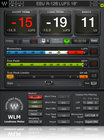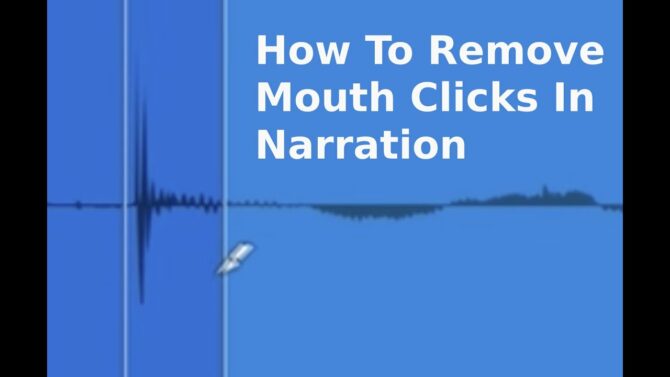The guidelines for mastering Definition:
Definition:
Compiling individual recordings into an album or collection of songs, or an individual song for a single release, often with added equalization, dynamics processing, and other signal processing to create a consistent and optimized listening experience. With albums, mastering can also involve determining the sequence of the individual recordings. are changing, but that’s not a bad thing. Let’s look at current “best practices” when mastering for CDs or streaming Definition:
Definition:
A method of sending a continuous flow of digital content over IP (Internet Protocol) networks, and often, tailors itself to the user's receiving capability. .
With vinyl, mastering was a complicated, fraught art due to the limitations of the playback medium. There was an unforgiving tradeoff of running time, level, frequency response Definition:
Definition:
The range of frequencies that an audio, video or data device can pass., surface noise Definition:
Definition:
Noise caused by the stylus traveling along the imperfectly smooth groove of a phonograph record., and distortion Definition:
Definition:
A change in an electronic or acoustic signal's waveform. This can undesirable if it impacts signal quality, or desirable when used for creative signal processing.. Mastering acquired its reputation as something mere mortals could never do, because only the best mastering engineers could navigate those tradeoffs successfully.
On the other hand, the CD’s digital Definition:
Definition:
A signal or data expressed as series of the digits 0 and 1, typically represented by values of a physical quantity such as voltage or magnetic polarization. technology was quite forgiving. Anyone with plug-ins and a computer could master a CD Definition:
Definition:
CD (Compact Disc): An optical-based, disc-shaped digital recording and playback medium. from a technical standpoint, although the need for finely-tuned ears, experience, and quality gear Definition:
Definition:
Musical or performance equipment. was still necessary to produce great masters. A “loudness war” developed for CDs, with the goal of creating the loudest possible perceived level, even if it involved sacrificing dynamics Definition:
Definition:
In a musical performance, changes in overall volume levels, often accompanied by timbral changes. Example: Classical symphonic music has a wide dynamic range, while dance mixes have a much narrower dynamic range. (and causing listener fatigue). This is because psycho-acoustically, the casual listener will think that given two songs, the louder one will sound “better.” Part of this is due to the Fletcher-Munson curve (Fig. 1), which shows that the ear has a flatter response at higher levels. Both bass and treble sound stronger than at lower levels.
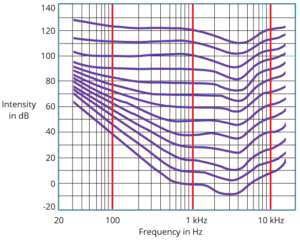
When playlist-oriented streaming services started to gain traction, they had a problem because the level variations among different pieces of music, recorded in different eras or mastered by different engineers, created an inconsistent experience where the listener had to adjust the volume level constantly. Furthermore, superb recordings with dynamic range Definition:
Definition:
1. Range in dB between a device's noise floor and its maximum available headroom. 2. The difference between the maximum and minimum volume levels that occur in a musical performance. were penalized, because they sounded “weaker.”
LUFS To The Rescue
Fortunately, an internationally agreed-upon level standard has gone a long way toward providing a solution. The EBU R128 specification defines levels in LUFS (Loudness Definition:
Definition:
1. An audio signal's perceived volume. 2. The quantifying of the ear's non-linear frequency response versus volume. See: Fletcher-Munson curve. Units Full Scale). This type of measurement doesn’t represent peak Definition:
Definition:
A signal's maximum level at any point in time. or average levels per se, but uses complex algorithms to arrive at a figure that represents perceived loudness. For example, audio with heavy dynamic range compression Definition:
Definition:
1. Reducing the dynamic range of an audio or video signal for consistency, to keep it from exceeding the available headroom, or providing a special effect. 2. With data, using a process to reduce the amount of data. Compression can be lossless, where decompressing replicates the original signal, or lossy, where compression occurs by judging some data as unnecessary, and can therefore be discarded from the file. produces a louder perceived volume (which translates to higher LUFS readings) than audio that isn’t compressed.
Broadcasters and streaming services started to adopt target LUFS readings as standards. For example, Spotify’s standard is -14 LUFS. If a heavily compressed song has an LUFS reading of -6, then it will be turned down until it produces a reading of -14 LUFS. The music will sound the same, but the volume will be consistent with other songs played on Spotify.
Problem Solved, Right? Well...
Programs with mastering capabilities include metering that analyzes your music, and provides an associated LUFS reading (Fig. 2).
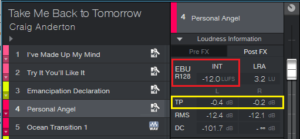
For programs that don’t have built-in LUFS metering, you can use plug-ins, such as Waves WLM Loudness meter (Fig. 3).
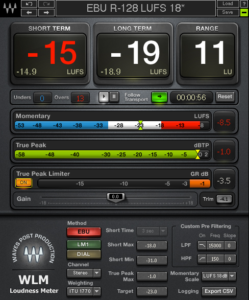
So it might seem we no longer need to concern ourselves with levels when mastering, because it’s all going to end up at the same perceived level anyway—all we have to do is make sure the LUFS reading for a given piece of music is -14 LUFS, and we’re done. But that’s not the case.
First, there’s no universally standard level. Apple Podcasts normalize LUFS levels to ‑16, YouTube to ‑13, and television to ‑24. But this doesn’t mean you have to master to different LUFS values. You master the music to what sounds right, and the streaming service will alter the perceived level to fit in with everything else. The more negative the LUFS number, the greater the dynamic range. So if you’re mastering something like a jazz ensemble or string quartet, you’ll want to master for a lower LUFS reading.
However, part of the sound of rock music is compression. A lot of pop albums are mastered to around ‑10 LUFS and up, or even ‑6 or ‑5 LUFS for dance-oriented tracks. This kind of compression brings up lower-level sounds, room ambiance, reduces peaks on drum hits, etc., so it changes the music’s character.
I’ve heard rock-oriented mastering engineers bemoan the fact that they feel compromised by having to master to -14 LUFS. But that’s missing the point—if you like the sound of compression, you can master the music to whatever LUFS level you like, because the streaming service will turn down the level to meet its LUFS standard. This doesn’t change the character of the music, only the volume—like turning a volume control up or down.
So the bottom line is simple: if you want to preserve more dynamics, master to a lower LUFS level, and you won’t be penalized for having a lower volume at the listener’s end. If you’re not as concerned about dynamics, master to whatever level sounds right.
Finally, we also need to consider True Peak readings. This is the peak level of music after it has undergone the conversion from digital to analog Definition:
Definition:
A signal that is continuous in nature, as opposed to being defined as a series of discrete numbers (or elements) as found in digital signals; electrically "analogous" to an acoustical signal in the air.. For reasons too complex to go into here, music peaks can appear to be under 0 dB Definition:
Definition:
1. A deciBel is a logarithmic ratio between two quantities, and is a nonlinear measurement that mimics human perception. 2. A unit expressing sound levels relative to a nominal level just audible by the average human ear, and equal to 1/10th of a Bel. 3. (slang) Database. in your mastering program, yet exceed the headroom Definition:
Definition:
1. The safety margin for an electronic signal that accommodates peak signals without overload. It is the difference (in dB) between normal operating levels (0-VU) and the clipping (overload) point. 2. The space between a subjects head or top and the top edge of a screen frame. of digital-to-analog converters. At low LUFS levels, it’s very rare to have True Peak readings over 0, but overall, you want to avoid True Peak levels over 0—especially when the music will be converted to MP3 Definition:
Definition:
A lossy digital compression coding format for audio, derived from the MPEG-1 and MPEG-2 formats. Audio compression can range from a data reduction ratio of 200:1 to broadcast quality (i.e., no noticeable audio degradation for the vast majority of listeners). MP3 streaming rates vary from 16 kilobit per second to 320 kilobits per second for stereo. Audio stored digitally in the MP3 format will have the .mp3 file extension., which requires a True Peak level no higher than -1 dB below 0, or more typically, -3 dB below 0.
Where Does This Leave CDs?
CDs are ceding market share with every passing month—sales have fallen by 80% over the past 10 years. But they’re not dead yet. They still occupy a prominent place for merch, with an older demographic that prefers owning music in a tangible form, and audiophiles of any age who find the fidelity superior to most streaming services. (There are high-resolution Definition:
Definition:
1. (video) The measure of pixels horizontally and vertically. For example, 1920x1080 is considered HD, or high-definition. 2. (audio) The combined bit depth and sample rate of a digital audio signal. streaming exceptions, like TIDAL, but they haven’t gotten as much traction as services that use data-compressed formats, like MP3 or AAC Definition:
Definition:
(Advanced Audio Coding): An audio coding standard for lossy digital audio compression, standardized by ISO and IEC..)
Underlying technologies include Ethernet, WiFi and Thread., the music usually ends up around -13 or -14. Bear in mind I’m not watching the LUFS readings like a hawk; once the music sounds the way I want, I do an LUFS reality check. The only time I really pay attention is when mastering an album. In that case, all the songs need to be in the same general range, consistent with artistic considerations (i.e., some songs are intended to sound softer or louder than others).
But if music is going to end up on CD, I’ll add some more compression before it goes off for pressing. Yes, this is a remnant of the loudness wars…but I don’t want the artist coming back to me and saying “it sounds so much softer than other CDs.” This doesn’t mean I’ll go full-on Metallica, but I try to make sure it won’t sound like the volume dropped off a cliff if a playlist Definition:
Definition:
1. A list of what programming is in rotation at a radio station. 2. A sequence of songs created by consumers for playback. 3. A feature of some DAWs that allows playing songs created in the DAW sequentially. sandwiches a song from the artist’s album between songs from other albums.
Someday, music will have dynamic range again (I can dream, can’t I?). Meanwhile, LUFS is a great start in that direction…maybe it will even educate listeners, to where they start demanding dynamic range from CDs as well.




